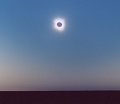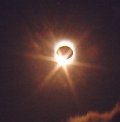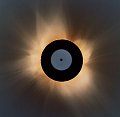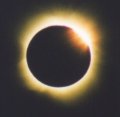| Photographer, Location | Images | Comments | |
|
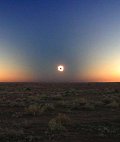
|
Suzanne Ireland,
the Australian Outback Dec. 4 |
#1 |
"The Moon's shadow was so narrow it was like looking down a tunnel and you could see it sweep across the sky," says Dale Ireland, whose wife Suzanne took this picture from the Australian Outback during the total solar eclipse of Dec. 4, 2002. |
|
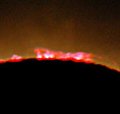
|
Mike
Foulkes, Derek Hatch, Paul Carter, Ann Davies, Val Stoneham,
between Lyndhurst and Farina Station, Australia Dec. 4 |
#1 |
M. Foulkes: "This composite image was taken with a 140mm F15 Maksutov; exposure 1/250 sec; D100 digital camera." |
|
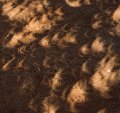
|
Brad Hoehne,
Beitbridge, Zimbabwe Dec. 4 |
#1, #2, #3, #4 |
B. Hoehne: "A tour group of 22 eclipse chasers and a number of curious locals set up under a beautiful baobab tree in southern Zimbabwe about 15 miles north of Bietbridge. (Note: image #1 shows crescent-shaped beams of light filtering through the baobob just before totality.) We witnessed about 1 minute and 20 seconds of glorious totality. The sky appeared to the eye a steel grey-blue. Lots of animal activity was witnessed. Shadow bands were very distinct, and evident on the red-brown dust and asphalt road. One member of our group managed to capture them quite convincingly on video tape. During totality Mercury could be seen quite easily with the naked eye. " |
|
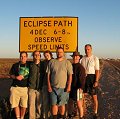
|
Emma & Henrik Herranen,
along the Stuart Highway, South Australia Dec. 4 |
#1, more |
E. Herranen: "Road officials had kindly put these road signs as well as a 60 km/h speed limit (instead of the standard 110 km/h) to the totality line. " Click here to see many more pictures of the eclipse itself. |
|
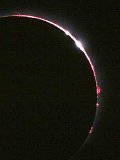
|
Bill
Kramer, Zimbabwe Dec. 4 |
#1, more | In this image, the sun's photosphere shines through two valleys along the horizon of the moon. Photo details: Fuji 400 slide film at prime focus of a Questar 90mm (EFL 1400 mm), 1/1000 of a second exposure. |
|
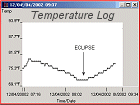
|
Gordon Telepun,
about 10 km north of Beitbridge, Zimbabwe Dec. 4 |
image, text file | Telepun, who was inside the path of totality, monitored the air temperature during the eclipse using an iButton device. The temperature plummeted 6 deg. F when the Moon's shadow swept by. "I tested the iButton in an ice water bath," says Telepun. "It was perfect--right on 32 degrees F. My laptop was synched to the atomic clock in Boulder, CO, the night before leaving for Africa, so the times are correct within 1 or 2 seconds (laptop clock error over 6 days duration). The iButton was 36 inches above the ground, hanging from the center pole of a tripod and shaded from the Sun with a white towel taped to the tripod legs. " |
|
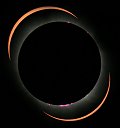
|
Angela and Gordon
Telepun, about 10 km north of Beitbridge, Zimbabwe Dec. 4 |
#1, #2 | G. Telepun: "This artistic composite is crescent partial phases 2 minutes before and after totality on each side of a full disk exposed for the prominences. Usually you will see composite pictures using full corona exposures. I did that last year. I think that this composite is different and interesting." |
|
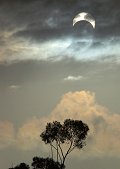
|
David
Johnston, Adelaide, Australia Dec. 4 |
#1, #2, more | D. Johnston: "I was on vacation in Adelaide, Australia at the time of the eclipse - about 300km or so from the path of totality. It was cloudy most all the day (same for Ceduna) but at the right time, the clouds parted... and in my case, they actually enhanced the photographs by dimming the sun enough that it didn't wash out the rest of the photo. I was trying to get shots of the landscape and the eclipse together since this was going to be a near sunset event. #1 is well before the maximum (Nikon D1x, 1/3200 sec, F/10 at 300mm); #2 was taken very near the maximum for Adelaide, which was about 88% (Nikon D1x, 1/6400 sec, F/10 at 270mm)." |
| Don
Pettit, International Space Station Dec. 4 |
#1, #2, more | Space Station science officer Don Pettit looked out the window on Wednesday during the total solar eclipse of Dec. 4th, and this is what he saw: The dark spot near the Earth's limb is the Moon's shadow, which at the time of the photo (approximately 0756 UT) was racing across the Indian Ocean. This is NASA image # ISS006-E-5065. |
|
|
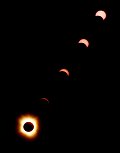
|
Craig Prater,
near Lyndhurst, Australia Dec. 4 |
#1, #2 | C. Prater: "These pictures were taken from
a dirt road 40 minutes outside of |
| Kearn Jones
and friends, in the outback of southern Australia Dec. 4 |
#1, more | K. Jones: "Note the shadow cone present in photo. It was awesome--like being in some sort galactic worm hole or eye of a hurricane. The ferocious blustery wind did drop off dramatically with the advent of totality and then slowly resumed as the sun came back out. Amazing! And all of us reported the sensation of being blissfully alone during totality. I want to see another one--to see if I imagined it all!! Special effects cannot ever match this awesome spectacle." |
|
| Olivier Staiger,
west of Woomera in southern, Australia Dec. 4 |
#1, more | This is a wide-angle view of the ongoing eclipse and the surrounding moon-shadow. |
|
| Col Maybury,
Kurri Kurri, NSW Australia Dec. 4 |
#1 | C. Maybury: "We traveled 10 days on a bus from Sydney to Ceduna--half way across our continent. It was cloudy all day on Dec. 4th, but the clouds parted for totality. I grabbed my camera for this hand held shot of the corona and 2nd diamond ring. The people of Ceduna were great, a small town in the outback with a big heart. Ricoh camera 400 ASA on auto. " |
|
| Jonathan Kern,
Messina, South Africa Dec. 4 |
#1 | Photo details: 5 second Newkirk exposure (raw) obtained at 06:18:36 UT, 10 seconds following 2nd contact. |
|
| Michael
Baker, near the outback town of Woomera in South Australia Dec. 4 |
#1, #2 | All
photos were taken with |
|
More images (click
on the name of the photographer to view the image): |

